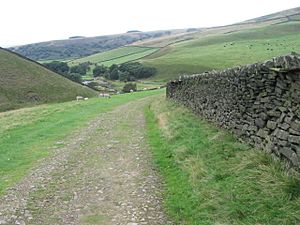Doctor's Gate facts for kids
Doctor's Gate is an ancient Roman road in the beautiful Peak District of England. It once connected two Roman forts: Melandra fort near Glossop and Navio fort at Brough-on-Noe. The name "Doctor's Gate" comes from "Docto Talbotes Gate," named after Dr. John Talbot. He is thought to have improved parts of the road in the late 1400s. The word 'gate' here means 'road', from an old Scandinavian word.
Contents
What is Doctor's Gate?
Doctor's Gate is a historic pathway built by the Romans. It helped them travel and move goods between their forts. These forts were important for controlling the area. The road was a vital link for the Roman army.
Where is Doctor's Gate?
This old road stretches across the moors of the Derbyshire Peak District. It starts near Glossop and goes all the way to Brough-on-Noe. This area is known for its stunning natural beauty.
Exploring the Route
Experts like Peter Wroe and Peter Mellor studied the route in the 1970s. The path you see on maps today is mostly a medieval packhorse route. This means it was used by horses carrying goods. It might be about 1 kilometer north of where the actual Roman road was on Ashop Moor. So, the original Roman path is a bit different from the modern one.
Who Looks After Doctor's Gate?
The National Trust helps protect parts of Doctor's Gate. They look after four main sections within their Hope Woodlands property:
- Blackley Hey section: This is a track through the Woodlands Valley. It runs north of Hope between Fulwood Stile Farm and a river crossing at Upper Ashop.
- Heyridge Farm section: This path connects Ashop Bridge and Oyster Clough.
- Lady Clough section: This part goes between Oyster Clough (east of the Snake Inn) and the Snake Pass.
- Summit section: This is a paved route. It stretches from Snake Pass (A57 road) to just past the Pennine Way walking path. The A57 road here was once a turnpike road from 1821, connecting Sheffield to Glossop.
How Do We Know It's Roman?
A historian named Ivan Donald Margary studied Roman roads. He gave Doctor's Gate the number RR711. Margary noted that the road was "remarkably direct." This is amazing because the land it crosses is very difficult. This shows how skilled Roman engineers were.


